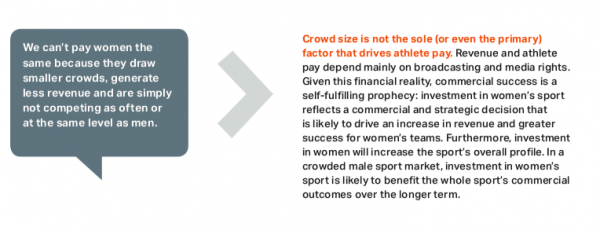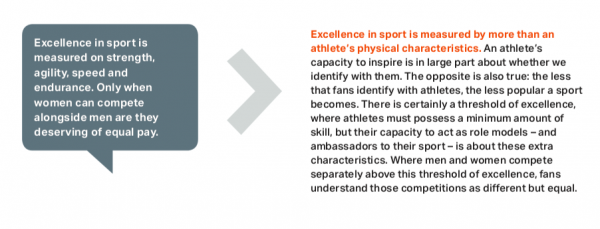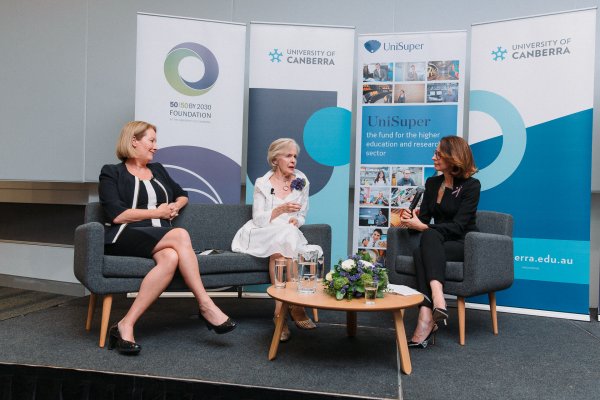Q1. As you mention in your new report, Male Champions of Change Pathway to Pay Equality, when it comes to gender pay inequity in sport, we’re talking about centuries of underinvestment in women’s sports – what was the catalyst for this work, why now?
I think the catalyst for the work was an increased understanding amongst the Male Champions of Change Sport that, if we were to address gender inequality in sport, we needed to go to the pointy end of the issue, and that was pay equality for elite female athletes. We had already looked at pay equality in administration and management roles in sport, which is really important, but just as important – and probably more difficult to actually progress – is the gender inequality in pay for female elite athletes, particularly when compared to their male counterparts.

Arguments against pay equity don’t stack up – Male Champions of Change Sport Pathway to Pay Equality
Q2. What about the community attitudes more broadly – the report lists several arguments against pay equity and you provide evidence for why they don’t stack up. How prevalent are these assumptions in the broader community?
It depends on which sports you’re looking at. Some sports have been on this journey for quite a long period of time. I’d definitely put sports like tennis and basketball and rowing, and more recently cricket in that category.
Tennis for example, has done a great job ensuring equal pay, equal exposure and equal investment at the elite level. They also do a lot to help people understand the value and uniqueness of the women’s game. You can’t argue about the payback on that investment when 20 million people in Japan alone tuned in to watch the Australian Open Women’s final this year!
And then you have sports, like football and rugby, where elite leagues for women are only just getting off the ground in the context of a very strong legacy of male-only players.
So, what the report does is make the task very tangible. Pay equality moves from a pipe dream to an achievable reality
The question for the CEOs was whether continuing this way – with a focus men’s game only – would make them strong in the future. I think that every one of the Male Champions agreed that the future was about sports for everyone, everywhere and that included men and women equally. The question is how to get to that place.
The group also understood that this is a hugely complex area to solve, so pay equality for female athletes is not going to come about next week or even next year. It will take time. However, in setting a strong pathway, using the best knowledge we have of what it takes, each sport aims to accelerate the pace of that change.
So, what the report does is make the task very tangible. Pay equality moves from a pipe dream to an achievable reality. We set out an approach, we provide a broad baseline assessment for each sport and they have committed to tracking and publicly reporting progress annually.

Q3. Last year in particular, there was a lot of media attention around the topic of prize money, especially when a junior surf event awarded the female winner half the amount of their male counterpart. World Surf League ended up announcing equal prize money for men and women, but this issue is far bigger than that. There is a whole ecosystem that exists before you even get to that point. At what point does this shift occur – that girls and women, despite doing the same sport, training as hard, simply aren’t worth as much?
I was really pleased to see that shift because the logic was irrefutable, and it was great to see the power of the community in achieving that change.
The report argues that each sport has to maintain a focus at each point of the Pathway in order to deliver pay equality.
We’re looking at the grassroots, so when a parent enrols their children in the local sporting club, their daughter has access to the same experience as their son. In many sporting organisations this still doesn’t happen.
One of the concerns I have as the former Sex discrimination Commissioner and now as the Special Rapporteur in the UN, is that we are still both explicitly and implicitly sending messages to young girls right from a very early age that maybe they’re not valued equally to boys.
One of the concerns I have as the former Sex discrimination Commissioner and now as the Special Rapporteur in the UN, is that we are still both explicitly and implicitly sending messages to young girls right from a very early age that maybe they’re not valued equally to boys.
This is not a message we want to send to our nation. So, in sport, we want to work from the grassroots right up to the elite level.
Another valuable element of the Pathway is that we unpick what the work of being an elite athlete looks like, breaking it into ‘work units’. We essentially break it down from a payment’s perspective – training payments, match payments, appearance payments, media payments. You are able to show where the work requirement is actually equal and where fair and reasonable pay should be an expectation.
If you’re a key player that draws fans to the game, you might get an extra allowance. If you or your team attract bigger audiences, you might get extra pay or a loading on top of the base pay. But the base pay should be equal because the work is equal.
So, it asks those questions – are men and women paid equally for these equal units of work, and if not, is there a very good reason for differential payment. It really makes transparent the whole pay structure of sport.

Q4. The gender pay gap in ‘Sports and Physical Recreation Activities’ workforce is 31.5% for full time employees – do we know how Australia stacks up against the rest of the world?
I don’t think we know. Australia is actually one of the only countries in the world that captures this type of data. In developing the report, we looked internationally for any other nations that had actually brought all the heads of their national sporting organisations together to act as a united front on pay equality, and we couldn’t find any other nations that have done this.
That was another reason to go ahead with the work and develop a strong conceptual framework to understand this and address this issue. And this framework, which we call ‘Pathway to Pay Equality’ will be very useful, not just here in Australia, but in other nations across the world.
Q5. Let’s talk about the role of affirmative action briefly, because we know that as soon as the term comes up, it brings up the concept of merit. In your report you discuss methods such as providing a higher base rate to account for the fact that there may initially be fewer opportunities to compete, or less sponsorship dollars available to elite women athletes. The opponents of affirmative action often argue that it undermines the merit principle. How would you respond to that?
The term ‘affirmative action’ sometimes has negative connotations for some, but the way we use it is just to state what is obvious and that is that for a number of sports, they’ve had hundred years of unequal investment in the men’s game. If we are to move to a situation of pay equality, then it may be necessary in certain instances to redress that inequality by setting a higher base bay for women in certain areas. For example, where an elite level women’s competition may be in an establishment phase in a sport and players may have few opportunities to be to be paid for their “work units” compared to their male counterparts.
We’re not prescriptive about that. All we’re saying is that we recognise that there may be a case for affirmative action in certain situations, particularly if we want to accelerate the pace at which a women’s sport moves from amateur to semi to fully professional.
It’s pretty clear that athletes who have the means to dedicate their entire week to their sport have an advantage over those forced to fit training and playing in around earning a living outside of sport.

IWD 2018: In Conversation with Elizabeth Broderick AO, Dame Quentin Bryce, and Virgina Haussegger AM, Dir 50/50 by 2030 Foundation, UC
Q6. What about the language we use? Often, you still hear people talk about ‘women’s sports’, whereas men’s sport is just ‘sport’, which runs the risk of reinforcing the male norm. Should be think about getting rid of the gendered distinction?
I’m all in favour of talking about sports for everyone, and not making the distinction, but what I would not want to do, is to lose sight of the inequality that currently exists by grouping sport all together.
Often when we’re just talking about sports in general, we go back to what the default position has been, and that is that many elite sports focus on men, it’s not on men and women equally.
So, I don’t want to lose the focus on ensuring that women can access, participate in, develop, have coaching opportunities, and have the opportunities to compete as an elite athlete and be celebrated in the same way as men do. We can’t lose that.
Q7. Finally, how close (or far!) are we to achieving pay equity in sports? Is it possible to estimate how many years it will take before we reach the goal?
I don’t think I can put an exact year on it because all sports have different starting positions. What I am sure we can do, is make significant progress so that in five years we’ll look back and say: ‘well that was when we drew a line in the sand’, and said we were no longer happy tolerate gender inequality in sport and large differences between men and women in equal pay as elite athletes.
And if there are differences, then they need to be differences which everyone in the community would say ‘yep, that should be different’, so they should be a justifiable differences.
It’s a call to action, a call to those other stakeholders to step up with the sporting organisations to make pay equality a reality
One great thing about the report is that it describes how there’s only certain things that the clubs themselves or the national sporting organisations can control. They can control certain levers and they need to move ahead with those levers, but that’s why this report was important because it reached out to other stakeholders like government, the broadcasters, the corporate sponsors, the players’ associations, the fans – and reminded everyone that every one of us plays a part in delivering pay equality for elite athletes. By themselves the sporting organisations are not able to do that, to deliver pay equality. What we need is everyone working in the same direction.
It’s a call to action, a call to those other stakeholders to step up with the sporting organisations to make pay equality a reality. So far, the reaction has been incredibly positive.





